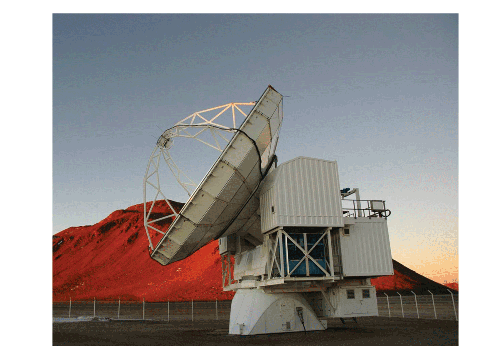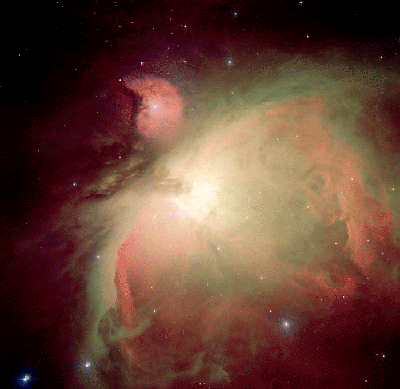A&A press release: The first science ever with APEX (13 July 2006)
- Details
- Published on 13 July 2006
A&A press release
Released on July 13th, 2006
|
The first science ever with APEX |
A special issue on the first results from APEX
(Published in Astronomy & Astrophysics, volume 454 n°2 – August I, 2006.)
This press release is issued as a collaboration with ESO, Max-Planck-Institut für Radioastronomie, and Astronomy & Astrophysics.
This week, Astronomy & Astrophysics is publishing a series of 26 articles dedicated to the first science
done with the 12-m sub-millimetre telescope Atacama Pathfinder EXperiment (APEX).
Situated 5100 metres high in Northern Chile, APEX is a forerunner to ALMA, a very large project involving Europe,
the United States, and Japan. APEX, and later ALMA, will observe the “cold universe”,
where stars like our Sun form.
This week, Astronomy & Astrophysics is publishing a series of 26 articles dedicated
to the first science done with the APEX telescope. The APEX telescope is located at 5100 metres,
at Chajnantor in the Atacama Desert (northern Chile). It will be dedicated to observing the sky of the Southern hemisphere
at “sub-millimetre wavelengths”. It covers so-called “atmospheric windows”
– the wavelengths at which the Earth’s atmosphere is partially transparent – between 0.1 mm and 1 mm.
APEX will thus be observing the “cold universe”, which radiates at these wavelengths.

Fig. 1 - The APEX telescope.
This “cold universe” includes the cold clouds where young stars are presently forming,
and in which the temperature is only -260°C. We believe our solar system formed from one of these cold clouds.
Astronomers studying these clouds are trying to understand what our solar system may have looked like just prior to
and just after the birth of the Sun. Other applications for APEX will be the study of stars losing mass in the last
stages of their evolution and of star-forming regions in different galaxies.
One scientific highlight in this issue is the discovery of a new interstellar molecule CF+, using both APEX and
the IRAM 30-metre telescope near Granada in Spain. Prior to this discovery,
there was only one fluorine-containing molecular species found in space so far.
This molecule was found in the neutral gas region adjoining the Orion Nebula.

Fig. 2 - The Orion Nebula (Messier 42). © ESO.
Another premiere is the detection – again in the Orion region – of radiation from carbon monoxide (CO)
at a wavelength of 0.2 mm. This is the work of Martina Wiedner (University of Cologne, Germany)
and her colleagues. These wavelengths are very difficult to investigate, both because the water vapour
in the atmosphere attenuates the signal, and because the light-collecting system technology is less
advanced at these wavelengths. The detection of CO at these wavelengths proves the efficiency of APEX,
and later that of ALMA.
Finally, H2D+ radiation was detected from several clouds in the Southern hemisphere
by two different teams: one lead by Jorma Harju (University of Helsinki, Finland),
the other with Michiel Hogerheijde (Leiden Observatory, Netherlands) and collaborators.
The H2D+ ion is interesting because it traces gas that is so cold (a few degrees above the absolute zero)
that only the lightest molecular species, including H2D+, have not frozen out onto the surfaces of dust grains.
Along with the Japanese 10-m ASTE telescope, APEX is the first
telescope dedicated to the sub-millimetre wavelengths in the Southern
hemisphere. Until now, this sort of science was only carried out in the
Northern hemisphere. APEX is indeed a forerunner to a large array of
sub-millimetre telescopes (ALMA or Atacama Large Millimeter Array).
ALMA will be built on the Chanjantor site, by a consortium from the
United States, Europe, and Japan. ALMA will consist of 50 telescopes of
the same dimensions (12-m diameter) as APEX, in an array which will
extend over 10 km. It will be built on the Chajnantor site between 2003
and 2012. APEX itself was constructed by a consortium of the
Max-Planck-Institut für Radioastronomie (Bonn, Germany), ESO, and the
Onsala Space Observatory (Sweden). Apart from its relevance in the
course of the ALMA project, APEX is interesting in its own right, as
illustrated by the wealth of results published in this special issue.
The Astronomy & Astrophysics special issue (volume 454 n° 2 – August I, 2006) on APEX first results includes 26 articles. They are freely available on the A&A web site.
Contact persons:
- Science:
Prof. Dr. Karl M. Menten
MPI für Radioastronomie
Auf dem Huegel 69
D-53121 Bonn, Germany
Email: kmenten (at) mpifr-bonn.mpg.de
Phone: +49 (0)228-525297
- Press office:
Dr. Jennifer Martin
Astronomy & Astrophysics
61, avenue de l'Observatoire
75014 Paris, France
Phone: +33 1 43 29 05 41 - Email: aanda.paris (at) obspm.fr


